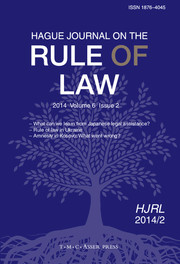Article contents
The Rule of Law as an Institutionalized Wager: Constitutions, Courts and Transformative Social Dynamics in Eastern Europe
Published online by Cambridge University Press: 28 September 2009
Abstract
Throughout the 1990s Eastern Europe was arguably the region most intensely studied and discussed by the community of scholars interested in the spread of the Rule of Law around the world. There was little doubt at the time that the political and institutional experiments whose ultimate goal was the establishment of democratic constitutional orders in the former Soviet satellites constitute a distinct object of study. This commonsensical view was supported by two kinds of arguments that accentuated the exceptional character of post-communist transformations.
There was, first, the question whether the attempt to transplant Western models to non-Western socio-cultural milieus is going to work at all. That new constitutions and laws must be adopted no one seriously doubted; but that grand acts of ‘founding’ would be sufficient no one earnestly believed. Second, analysts probing the complexities of East European politics pointed out that fledgling democratic regimes there face a ‘rule-of-law dilemma,’ namely a situation where ‘what is deemed just is contingent and informed by prior injustice’ and ‘the value of legal change is in tension with the value of adherence to the principle of settled legal precedent.’ Since the ‘special conditions’ that societies emerging from the long night of authoritarianism render conventional conception of the Rule of Law ‘inapplicable or only partially applicable,’ ‘an exceptionalist paradigm’ was necessary, one that is more sensitive to contextual peculiarities. Should the agents of the previous regime be punished? And if so, in accordance with what criminal laws and pursuant to what legal procedures? Should property confiscated by previous regimes be returned to former owners and their descendants? Would it be justified to apply new laws retroactively in order to remedy past injustices? It was far from clear whether such intractable questions lend themselves to just and normatively desirable solutions compatible with an overarching commitment to the Rule of Law.
In this paper I will defend the view that the conversation about what is sui generis about post-communist polities should continue. But I will also argue that in order to understand the specificity of post-communist constitutional orders, we should shift our attention from the related issues of the fate of constitutional transplants and the dilemmas of exceptionalist jurisprudence towards the more or less permanent institutional characteristics of these orders. The change of focus does not mean that the problematique of ‘the transition’ should be abandoned; but it invites us to take a fresh look at what transpired during the 1990s and recalibrate our understanding of what the truly important, enduring legacies of that decade are. Such an endeavor must begin with a careful account of the actual results of the region-wide attempt to introduce the Rule of Law, and in what follows I will focus on the effort to establish independent Constitutional and regular courts. As I will show, postcommunist experiences should be interpreted through the prism of two broad analytical themes: the balance of power between pro-law and anti-law constituencies in society, and the statist dimension of the Rule of Law, or the manner in which this set of principles and practices is embedded in, and affected by, the organizational infrastructure of governance. Explorations of the specificity of post-transitional Rule of Law will thus yield insights into this key yet understudied issue, the nature of the social and institutional factors that facilitate or obstruct the growth of this form of modern democratic governance.
- Type
- Articles
- Information
- Copyright
- Copyright © T.M.C. Asser Press and the Authors 2009
- 7
- Cited by




